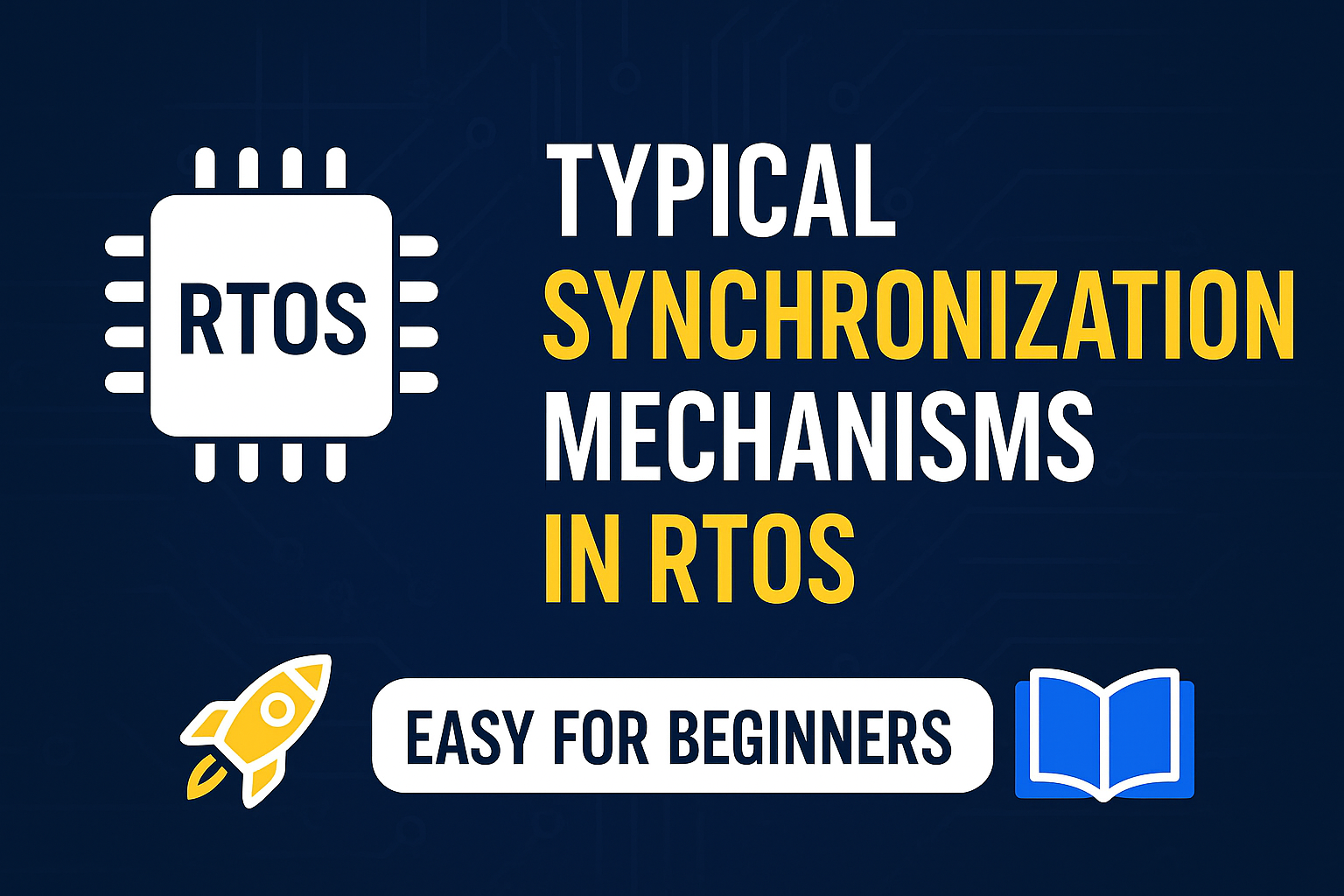Typical synchronization mechanisms used in an RTOS (Real-Time Operating System) are techniques that manage the coordination and safe sharing of resources among multiple tasks running concurrently. These mechanisms—such as semaphores, mutexes, event flags, message queues, mailboxes, and barriers—help prevent race conditions, ensure mutual exclusion, and maintain deterministic behavior in time-critical applications. By enabling controlled access to shared memory, devices, and data structures, they keep real-time systems stable, predictable, and efficient. Whether it’s signaling between tasks, protecting resources, or coordinating task execution, these synchronization tools are essential for reliable RTOS performance.
Typical Synchronization Mechanisms Used in an RTOS
In a Real-Time Operating System (RTOS), multiple tasks often run concurrently and may need to share resources such as memory, hardware devices, or data structures. Without proper control, two tasks could try to access the same resource at the same time, leading to race conditions or data corruption.
This is where synchronization mechanisms come into play. They ensure safe, predictable, and coordinated access to shared resources, maintaining system stability in real-time environments.
Why Synchronization is Important in RTOS
In real-time systems, timing and reliability are critical. Synchronization helps to:
- Prevent race conditions and data corruption
- Ensure mutual exclusion (only one task can access a resource at a time)
- Maintain task coordination and predictable behavior
- Improve system stability and deterministic performance
Typical Synchronization Mechanisms Used in RTOS
1. Semaphores
A semaphore is a signaling mechanism that controls access to resources.
- Binary Semaphore: Works like an on/off flag. Useful for task signaling and simple mutual exclusion.
- Counting Semaphore: Allows a fixed number of tasks to access a resource simultaneously.
Example: In an RTOS-based printer control system, a counting semaphore can allow up to 3 print jobs to be queued at the same time.
2. Mutex (Mutual Exclusion)
A mutex ensures that only one task can access a shared resource at any given moment.
- Often supports priority inheritance, which helps prevent priority inversion problems in real-time systems.
Example: Protecting a shared log file from being written by multiple tasks at the same time.
3. Event Flags
Event flags (or event groups) allow tasks to wait for specific conditions to occur.
- Multiple bits in a flag group can represent different events.
- Tasks can wait for any or all events to be set before proceeding.
Example: A task waits for both “data received” and “data processed” flags before sending the next packet.
4. Message Queues
Message queues allow safe communication between tasks by sending and receiving messages in FIFO (First In, First Out) order.
- Helps decouple tasks — the sender and receiver do not need to run at the same time.
- Supports data passing with built-in synchronization.
Example: A sensor task sends temperature readings to a processing task via a message queue.
5. Mailboxes
A mailbox is like a message queue but usually designed for fixed-size messages and single message storage.
- Suitable when tasks need to exchange small messages quickly.
Example: A control task sends a command to a motor driver task using a mailbox.
6. Barriers
A barrier is a synchronization point where multiple tasks must wait until all have reached the barrier before continuing.
- Useful for coordinating stages in multi-task processing.
Example: In a multi-core RTOS system, all tasks wait at a barrier until data loading is complete.
Choosing the Right Mechanism
The right synchronization mechanism depends on:
- Type of resource (shared memory, hardware device, data buffer)
- Number of tasks accessing the resource
- Real-time constraints and timing requirements
- Data size and communication frequency
Quick Guide:
- Use mutex for exclusive access to a resource.
- Use semaphore for signaling between tasks or controlling resource count.
- Use event flags for multi-condition synchronization.
- Use message queues/mailboxes for safe inter-task communication.
- Use barriers for group synchronization.
Final Thoughts
In an RTOS, synchronization mechanisms are essential for building stable, predictable, and safe embedded applications. Whether you are working with FreeRTOS, QNX, VxWorks, or any other RTOS, mastering semaphores, mutexes, event flags, and message queues will significantly improve your ability to design efficient real-time systems.
FAQ – Typical Synchronization Mechanisms in an RTOS
1. What is synchronization in an RTOS?
Synchronization in an RTOS ensures that multiple tasks can safely share resources without conflicts or data corruption. It helps coordinate task execution and maintain predictable system behavior.
2. Why is synchronization important in real-time systems?
In real-time systems, timing is critical. Synchronization prevents race conditions, ensures mutual exclusion, and keeps system performance consistent and deterministic.
3. What are the most common synchronization mechanisms in RTOS?
The most common synchronization mechanisms include:
- Semaphores (binary and counting)
- Mutexes
- Event flags
- Message queues
- Mailboxes
- Barriers
4. What is the difference between a semaphore and a mutex in RTOS?
A semaphore is a signaling mechanism that can be used by multiple tasks, while a mutex provides exclusive access to a resource and usually supports priority inheritance to avoid priority inversion.
5. When should I use event flags in RTOS?
Event flags are best when a task must wait for one or more conditions to occur before continuing execution—such as waiting for multiple sensors to signal readiness.
6. What is a message queue used for in RTOS?
A message queue allows tasks to send and receive data safely, even if they run at different times. It supports FIFO ordering and prevents data loss during task communication.
7. Do all RTOS platforms support the same synchronization mechanisms?
No. While most RTOS platforms support semaphores, mutexes, and message queues, advanced features like barriers or event flags may vary depending on the RTOS (e.g., FreeRTOS, QNX, VxWorks).
You can also Visit other tutorials of Embedded Prep
- Multithreading in C++
- Multithreading Interview Questions
- Multithreading in Operating System
- Multithreading in Java
- POSIX Threads pthread Beginner’s Guide in C/C++
- Speed Up Code using Multithreading
- Limitations of Multithreading
- Common Issues in Multithreading
- Multithreading Program with One Thread for Addition and One for Multiplication
- Advantage of Multithreading
- Disadvantages of Multithreading
- Applications of Multithreading: How Multithreading Makes Modern Software Faster and Smarter”
- Master CAN Bus Interview Questions 2025
- What Does CAN Stand For in CAN Bus?
- CAN Bus Message Filtering Explained
- CAN Bus Communication Between Nodes With Different Bit Rates
- How Does CAN Bus Handle Message Collisions
- Message Priority Using Identifiers in CAN Protocol
Mr. Raj Kumar is a highly experienced Technical Content Engineer with 7 years of dedicated expertise in the intricate field of embedded systems. At Embedded Prep, Raj is at the forefront of creating and curating high-quality technical content designed to educate and empower aspiring and seasoned professionals in the embedded domain.
Throughout his career, Raj has honed a unique skill set that bridges the gap between deep technical understanding and effective communication. His work encompasses a wide range of educational materials, including in-depth tutorials, practical guides, course modules, and insightful articles focused on embedded hardware and software solutions. He possesses a strong grasp of embedded architectures, microcontrollers, real-time operating systems (RTOS), firmware development, and various communication protocols relevant to the embedded industry.
Raj is adept at collaborating closely with subject matter experts, engineers, and instructional designers to ensure the accuracy, completeness, and pedagogical effectiveness of the content. His meticulous attention to detail and commitment to clarity are instrumental in transforming complex embedded concepts into easily digestible and engaging learning experiences. At Embedded Prep, he plays a crucial role in building a robust knowledge base that helps learners master the complexities of embedded technologies.




Leave a Reply